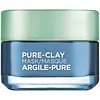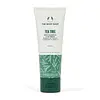What's inside
What's inside
 Key Ingredients
Key Ingredients

 Benefits
Benefits

 Concerns
Concerns

 Ingredients Side-by-side
Ingredients Side-by-side

Water
Skin ConditioningKaolin
AbrasiveGlycerin
HumectantAlcohol Denat.
AntimicrobialIsononyl Isononanoate
EmollientCetearyl Alcohol
EmollientMica
Cosmetic ColorantCI 77891
Cosmetic ColorantStearic Acid
CleansingStearyl Alcohol
EmollientZinc Sulfate
AntimicrobialGlyceryl Stearate Citrate
EmollientCetearyl Glucoside
EmulsifyingSodium Hydroxide
BufferingLaminaria Saccharina Extract
Skin ProtectingPyridoxine Hcl
Skin ConditioningMyristic Acid
CleansingPalmitic Acid
EmollientMoroccan Lava Clay
AbrasiveCapryloyl Glycine
CleansingXanthan Gum
EmulsifyingMontmorillonite
AbsorbentButylene Glycol
HumectantTocopherol
AntioxidantPhenoxyethanol
PreservativeCI 77499
Cosmetic ColorantCI 77510
Cosmetic ColorantLinalool
PerfumingLimonene
PerfumingParfum
MaskingWater, Kaolin, Glycerin, Alcohol Denat., Isononyl Isononanoate, Cetearyl Alcohol, Mica, CI 77891, Stearic Acid, Stearyl Alcohol, Zinc Sulfate, Glyceryl Stearate Citrate, Cetearyl Glucoside, Sodium Hydroxide, Laminaria Saccharina Extract, Pyridoxine Hcl, Myristic Acid, Palmitic Acid, Moroccan Lava Clay, Capryloyl Glycine, Xanthan Gum, Montmorillonite, Butylene Glycol, Tocopherol, Phenoxyethanol, CI 77499, CI 77510, Linalool, Limonene, Parfum
Water
Skin ConditioningKaolin
AbrasiveGlycerin
HumectantCaprylic/Capric Triglyceride
MaskingPropanediol
SolventCetyl Alcohol
EmollientArachidyl Alcohol
EmollientButyrospermum Parkii Butter
Skin ConditioningBehenyl Alcohol
EmollientArgilla
AbrasiveAcrylates/Beheneth-25 Methacrylate Copolymer
Phenoxyethanol
PreservativeXanthan Gum
EmulsifyingArachidyl Glucoside
EmulsifyingCalophyllum Inophyllum Seed Oil
AntimicrobialCaprylyl Glycol
EmollientMelaleuca Alternifolia Leaf Oil
AntioxidantCoco-Caprylate/Caprate
EmollientSalicylic Acid
MaskingTriheptanoin
Skin ConditioningSodium Hydroxide
BufferingMenthol
MaskingTrisodium Ethylenediamine Disuccinate
C9-12 Alkane
SolventDilinoleic Acid/Butanediol Copolymer
Limonene
PerfumingCitral
PerfumingLinalool
PerfumingCastor Oil/Ipdi Copolymer
Citronellol
PerfumingLeptospermum Petersonii Oil
MaskingCitric Acid
BufferingTocopherol
AntioxidantCI 19140
Cosmetic ColorantCI 42090
Cosmetic ColorantWater, Kaolin, Glycerin, Caprylic/Capric Triglyceride, Propanediol, Cetyl Alcohol, Arachidyl Alcohol, Butyrospermum Parkii Butter, Behenyl Alcohol, Argilla, Acrylates/Beheneth-25 Methacrylate Copolymer, Phenoxyethanol, Xanthan Gum, Arachidyl Glucoside, Calophyllum Inophyllum Seed Oil, Caprylyl Glycol, Melaleuca Alternifolia Leaf Oil, Coco-Caprylate/Caprate, Salicylic Acid, Triheptanoin, Sodium Hydroxide, Menthol, Trisodium Ethylenediamine Disuccinate, C9-12 Alkane, Dilinoleic Acid/Butanediol Copolymer, Limonene, Citral, Linalool, Castor Oil/Ipdi Copolymer, Citronellol, Leptospermum Petersonii Oil, Citric Acid, Tocopherol, CI 19140, CI 42090
 Reviews
Reviews

Ingredients Explained
These ingredients are found in both products.
Ingredients higher up in an ingredient list are typically present in a larger amount.
Glycerin is already naturally found in your skin. It helps moisturize and protect your skin.
A study from 2016 found glycerin to be more effective as a humectant than AHAs and hyaluronic acid.
As a humectant, it helps the skin stay hydrated by pulling moisture to your skin. The low molecular weight of glycerin allows it to pull moisture into the deeper layers of your skin.
Hydrated skin improves your skin barrier; Your skin barrier helps protect against irritants and bacteria.
Glycerin has also been found to have antimicrobial and antiviral properties. Due to these properties, glycerin is often used in wound and burn treatments.
In cosmetics, glycerin is usually derived from plants such as soybean or palm. However, it can also be sourced from animals, such as tallow or animal fat.
This ingredient is organic, colorless, odorless, and non-toxic.
Glycerin is the name for this ingredient in American English. British English uses Glycerol/Glycerine.
Learn more about GlycerinKaolin is a clay. It is used for oil control and to help minimize pores. Like other clays, kaolin has the ability to absorb excess sebum or oil. This can help clean out pores and mattify the skin.
Some types of kaolin may have exfoliating properties. When water is added to kaolin, it becomes a paste with small abrasive particles.
Most kaolin is a white color, but may be pink/orange/red depending on where it comes from.
The name 'kaolin' comes from a Chinese village named 'Gaoling'. Kaolin clay comes from rocks rich in kaolinite. Kaolinite, the mineral, has a silicate layered structure. Kaolinite is formed from chemical weathering of aluminum siilicate minerals.
Besides skincare, kaolin is commonly used to make glossy paper, in ceramics, toothpaste, and as medicine to soothe stomach issues.
Learn more about KaolinLimonene is a fragrance that adds scent and taste to a formulation.
It's found in the peel oil of citrus fruits and other plants such as lavender and eucalyptus. The scent of limonene is generally described as "sweet citrus".
Limonene acts as an antioxidant, meaning it helps neutralize free radicals.
When exposed to air, oxidized limonene may sensitize the skin. Because of this, limonene is often avoided by people with sensitive skin.
The term 'fragrance' is not regulated in many countries. In many cases, it is up to the brand to define this term. For instance, many brands choose to label themselves as "fragrance-free" because they are not using synthetic fragrances. However, their products may still contain ingredients such as essential oils that are considered a fragrance.
Learn more about LimoneneLinalool is a fragrance and helps add scent to products. It's derived from common plants such as cinnamon, mint, citrus, and lavender.
Like Limonene, this ingredient oxidizes when exposed to air. Oxidized linalool can cause allergies and skin sensitivity.
This ingredient has a scent that is floral, spicy tropical, and citrus-like.
Learn more about LinaloolPhenoxyethanol is a preservative that has germicide, antimicrobial, and aromatic properties. Studies show that phenoxyethanol can prevent microbial growth. By itself, it has a scent that is similar to that of a rose.
It's often used in formulations along with Caprylyl Glycol to preserve the shelf life of products.
Sodium Hydroxide is also known as lye or caustic soda. It is used to adjust the pH of products; many ingredients require a specific pH to be effective.
In small amounts, sodium hydroxide is considered safe to use. However, large amounts may cause chemical burns due to its high alkaline.
Your skin has a natural pH and acid mantle. This acid mantle helps prevent harmful bacteria from breaking through. The acid mantle also helps keep your skin hydrated.
"Alkaline" refers to a high pH level. A low pH level would be considered acidic.
Learn more about Sodium HydroxideTocopherol (also known as Vitamin E) is a common antioxidant used to help protect the skin from free-radicals and strengthen the skin barrier. It's also fat soluble - this means our skin is great at absorbing it.
Vitamin E also helps keep your natural skin lipids healthy. Your lipid skin barrier naturally consists of lipids, ceramides, and fatty acids. Vitamin E offers extra protection for your skin’s lipid barrier, keeping your skin healthy and nourished.
Another benefit is a bit of UV protection. Vitamin E helps reduce the damage caused by UVB rays. (It should not replace your sunscreen). Combining it with Vitamin C can decrease sunburned cells and hyperpigmentation after UV exposure.
You might have noticed Vitamin E + C often paired together. This is because it is great at stabilizing Vitamin C. Using the two together helps increase the effectiveness of both ingredients.
There are often claims that Vitamin E can reduce/prevent scarring, but these claims haven't been confirmed by scientific research.
Learn more about TocopherolWater. It's the most common cosmetic ingredient of all. You'll usually see it at the top of ingredient lists, meaning that it makes up the largest part of the product.
So why is it so popular? Water most often acts as a solvent - this means that it helps dissolve other ingredients into the formulation.
You'll also recognize water as that liquid we all need to stay alive. If you see this, drink a glass of water. Stay hydrated!
Learn more about WaterXanthan gum is used as a stabilizer and thickener within cosmetic products. It helps give products a sticky, thick feeling - preventing them from being too runny.
On the technical side of things, xanthan gum is a polysaccharide - a combination consisting of multiple sugar molecules bonded together.
Xanthan gum is a pretty common and great ingredient. It is a natural, non-toxic, non-irritating ingredient that is also commonly used in food products.
Learn more about Xanthan Gum